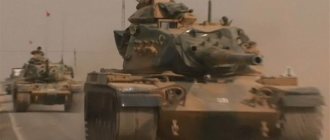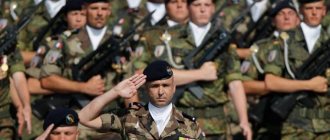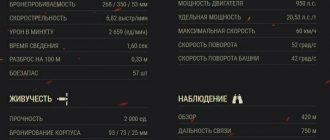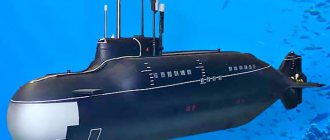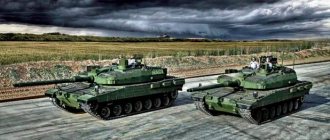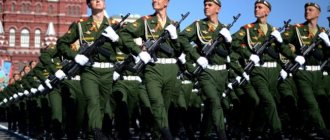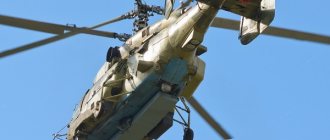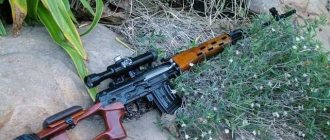Turkish Navy. Review
The Turkish Navy has (after reorganization): 165 warships and boats (including 16 frigates, 10 corvettes, 16 patrol ships, 13 submarines, 11 minesweepers, 33 landing ships and boats, 18 missile boats and 33 patrol boats) , 16 basic patrol aircraft and 38 helicopters. The basis of the surface fleet is made up of 24 patrol ships: 16 frigates and 10 large multi-purpose corvettes. The Turkish fleet has a solid total displacement of ships of the main classes - 88,500 tons (for comparison: Germany - 56,800 tons). Ankara, strengthening its geopolitical positions, army and navy, and economy, has become a powerful regional power. Turkey, the only one of the Black Sea countries, besides Russia, of course, has submarines, partially built at local shipyards according to German designs. In total, the Turks have 13 submarines in service: - 5 Atılay-class of the German project 209/1200, with a displacement of 1600 tons, 1979-1989. buildings (the number 1200 means the displacement of the boat). The average repair with the installation of an air-independent engine has been cancelled. Limited modernization is planned.
Tactical and technical characteristics of project 209/1200. Displacement: 990 tons - surface and 1200 tons - underwater. Length - 56 m. Width - 6 m. Draft - 5.5 m. Maximum surface speed - 10, underwater - 22 knots. Cruising range - up to 5000 miles at a speed of 8 knots. The ship's single-shaft power plant consists of four diesel generators (DG) with a power of 1000 hp each. each, and a main propulsion electric motor (MEM) with a power of 5000 hp. The armament consists of eight 533-mm torpedo tubes with an ammunition load of up to 20 torpedoes. Crew - 33 people.
— 4 Preveze-class project 209T1/1400, with a displacement of 1800 tons, 1994-1999. the buildings.
Tactical and technical characteristics of project 209T1/1400. Displacement - up to 1464/1586 tons. Maximum surface speed - 10, underwater - 22 knots. Length - 62 m, width - 6.2 m. Draft 5.5 m. Cruising range - 5000 miles, but at half the speed, i.e. only 4 knots. The power plant on submarines consists of four MTU 12V396 SB83 diesel generators with 900 hp each. and one 4000 hp power propulsion engine. Crew - 35 people. — 4 Gür-class project 209T2/1400, with a displacement of 1800 tons, 2003-2007. the buildings. The boats are armed with 8 bow torpedo tubes of 533 mm caliber, ammunition of 14 torpedoes, and the installation of Sub Harpoon anti-ship missiles and sea mines.
Turkish diesel-electric submarine S 357 Gür of project 209T2/1400 in the Bosphorus Boats of the Preveze and Gür classes are even less noisy than Atılay, and due to their small dimensions they are also difficult to detect. The low autonomy and low underwater speed of Turkish boats are compensated by increasing combat effectiveness due to the introduction of Sub Harpoon anti-ship missiles into the ammunition load. The downside to this weapon is that Ankara is completely technologically dependent on the United States: missiles, containers, test and auxiliary equipment, spare parts, technical documentation for anti-ship missiles are all from the States. The Pentagon continues to train Turkish naval personnel, provide technical support for UGM-84L missiles, and perform other tasks related to the material support of anti-ship missiles. It is planned that the Project 209T1/1400 boats will be replaced by 6 Type 214 boats, with a diesel propulsion system combined with an air-independent propulsion system (AIP) based on Siemens polymer electrolytic membrane (PEM) hydrogen fuel cells, being built at Turkish shipyards. Since the Turkish type 214 will have a huge number of native Turkish systems on board, it was decided to call this version of the boat type 214TN (Turkish Navy). HDW will assemble major body and mechanical components and classified components such as fuel cells and propulsion system in Germany and then transport them to the assembly site. All electronic components and weapon systems (including the C4I system) will be produced and installed directly in Turkey. However, today the lag from the original program schedule is estimated at six years. The delay in the construction of the submarines was caused by problems with financing and design errors, fraught with loss of stability on the surface. As a result, construction of the first submarine of the Piri Reis series began only in 2015. It is planned to be transferred to the fleet in 2022. And completion of delivery of all six submarines is expected by 2026. Project 214 submarines reach a length of 65 meters with an underwater displacement of 1,860 tons. The boats are manufactured using stealth technology, equipped with a combined diesel-electric/anaerobic (air-independent fuel cell) power plant, which allows the submarine to move without surfacing for more than 10 days. Submerged speed is up to 20 knots, surfaced – 12 knots. Immersion depth is up to 400 meters. Project 214 submarines are armed with eight 533-mm torpedo tubes and can also lay minefields. On October 24 of this year, the Turkish Ministry of Defense announced the launch of MiLDEN, a project to build domestic combat submarines. MiLDEN is short for Milli Denizalti, which translates to "national submarine". The first submarine is planned to be put into service by 2040, and it will be built on the basis of the German Type 209 project. The surface forces of the fleet are 14 frigates, of which: - 8 former American "Oliver H. Perry" received in 1997-2003 . from the US Navy Reserve. Displacement - 4100 tons. Length – 135.64 m, width – 13.72 m, draft – 7.5 m. Power plant: 2 General Electric LM2500-30 gas turbine units, 1 shaft, 41,000 hp. (31 MW), 2 aux. diesel (650 hp), 2 thrusters. Speed – 29 knots. Cruising range – 4500/20. Armament: 1x1 MK13Mod.4 launcher Tartar/Harpoon anti-aircraft missile system (32 SM-1 MR missiles and 8 Harpoon); 1x1 76-mm gun OTO Melara Mk75, 1x6 20-mm MZAK Mk15 Vulcan-Phalanx, 2x3 324-mm TA Mk32 (6 Mk46 or Mk50 torpedoes), 1-2 SH-2F Seasprite LAMPS Mk I helicopters (on FFG 7, 8 , 9-19, 29-32) in the hangar. Crew – 205 people. (15 officers). Due to the moral and technical obsolescence of the ships, it was decided to subject them to large-scale modernization under the GENESIS program. The modernization included a major replacement of the ships' electronics, improving their weapons and bringing systems into line with Turkish standards. During the modernization, the ships were equipped with the new GENESIS BIUS, a highly efficient fully automatic system capable of tracking and identifying up to 1000 targets simultaneously. The radar equipment of the frigates was replaced by a new three-dimensional radar SMART-S, made in Holland, capable of detecting air targets at a distance of up to 250 kilometers. The ships also received a new long-range search sonar. The ships' armament was supplemented by an eight-cell Mk 41 vertical launcher installed in the bow in front of the Mk 13 beam launcher. The launcher is used to accommodate the Evolved Sea Sparrow Missile, significantly expanding the frigate's close-in air defense and low-flying missile capabilities. The flight decks at the stern of the frigates were adapted to operate S-70 Seahawk helicopters. The first G-type frigate (as the modernized frigates in the Turkish Navy began to be called) was accepted into the Navy in 2007, the last - in 2011. At the moment, eight G-type frigates form the basis of the long-range air defense of the Turkish fleet, as no other Turkish ship not capable of carrying long-range SM-1MR missiles. True, only God knows how combat-ready the medium-radius air defense system “Standard SM-1MR” (Vietnam War veteran) is.
Frigate TCG “Gediz” (F-495) Turkish Navy - 4 DE MEKO 200TN Track IIA frigates were built in Turkey according to the modified German MEKO 2000 project. New navigation, artillery control and radio countermeasures systems were installed. Displacement 3300 tons. Length – 116.72 m, width – 14.8 m, draft – 4.25 m. Power plant – twin-shaft, 2 gas turbines GE LM-2500 (63532 hp), 2 diesel engines MTU 16V 1163 TB83 (13060 hp .). Speed – 32 knots. Cruising range – 4100/18. Armament: 2x4 Harpoon anti-ship missile launchers, 1x16 UVP Mk41 Mod.8 (Sea Sparrow ESSM), 127-mm Mk45 Mod.1 gun, 3x4 25-mm MZAK Oerlikon Contraves GM25-52 Sea Zenith, 2x3 324-mm TA Mk32 (Mk46 Mod .5), 1 helicopter AV.212. Crew – 180 people. (24 off.)
Frigate TCG "Turgutreis" (F-241) Turkish Navy - 4 frigates DE MEKO 200TN Track I. The first two MEKO 200TN frigates for the Turkish Navy were built in Germany (Blohm und Voss, HDW): F240 Yavuz, F241 Turgut Reis and transferred to the Turkish Navy in 1988 and 1989 respectively. 2 more were built in Turkey. Displacement: 3000 tons. Length – 110.5 m, width – 14.2 m, draft – 3.94 m. Power plant – twin-shaft, 4 diesel engines MTU 20V1163 TB93, 29940 hp. Speed – 27 knots. Cruising range – 4000/18. Armament: 2x4 Harpoon anti-ship missile launchers, 1x8 Mk29 Mod.1 launchers Sea Sparrow air defense missile system (16 missiles), 1 127-mm Mk45 Mod.1 AU, 3x4 25-mm MZAK Oerlikon Contraves Sea Zenith GM25, 2x3 324-mm Mk32 (Mk46) TA Mod.5), 1 helicopter АВ.212. Crew – 180 people. (26 of.).
Turkish frigate TCG "Barbaros" (F-244) project DE MEKO 200TN Track IIA In January 1996, Turkey began development of a frigate of its own project TF-2000 (Turkish Frigate-2000), the prototype of which was the Norwegian frigate F-310 "Fridtjof Nansen" , which received the status of a nationwide military ship program. It is a multi-role stealth combat ship capable of performing a range of missions, including reconnaissance, surveillance, target identification, early warning, anti-submarine and anti-surface ship, and air defense functions. The lead ship of the series is due to leave the slipways of the Turkish shipyard Golcuk in 2022.
Proposed appearance of the promising Turkish frigate TF-2000 (Turkish Frigate-2000). The numbers indicate : 1) Sea Hawk helicopter (one or two); 2) 12.7 mm remote-controlled heavy machine guns STAMP (4x1); 3) Mk 49 launcher for the closest missile defense system Mk 31 for RAM/RIM-116 missiles (2x21); 4) UVP air defense missile system, most likely zonal defense (5x8); 5) TA (2x2); 6) early warning radar, possibly SMART-L; 7) electro-optical sighting station; PU anti-ship missiles (2x8); 9) radar with phased array ÇAFRAD; 10) UVP for CRBD?; 11) 127 mm AU. 10 corvettes: - 4 Turkish-built MILGEM (Ada type) . In fact, the project was developed for the Turkish Navy with the participation of the Nikolaev State Research and Design Center for Shipbuilding (IPTSK, Ukraine). Displacement: 2,300 tons. Length – 99.56 m, width – 14.4 m, draft – 3.89 m. Power plant – two-shaft, 1 gas turbine unit, 2 diesel engines, 30,000 kW. Speed – 29 knots. Cruising range – 3500/15. Crew – 93 people. Armament: 2x4 Harpoon Block II anti-ship missile launchers, Mk41 UVP, 1x21 RAM SAM launchers, 1 76-mm artillery gun, 2x3 324-mm Mk32 TA, 2 12.7-mm machine guns, 1 S-70B-2 Sea Hawk helicopter. A total of 12 corvettes of this project are planned to be built, but so far the construction of only four ships has been authorized. Construction of the lead corvette F 511 Heybeliada has been carried out at the Istanbul Naval Shipyard since January 2007 and the ship was commissioned into the Turkish fleet in September 2011. The second corvette F 512 Büyükada was delivered to the Turkish Navy in September 2013, the third corvette F 513 Burgazada in November 2022, and the fourth corvette F 514 Kınalıada on September 29 this year. The newest corvette Kinaliada was the first in the Turkish Navy to receive the Turkish-developed Atmaca anti-ship missile system; sea tests of this complex should begin later on this ship.
2) 12.7 mm remote-controlled heavy machine guns STAMP (4x1); 3) Mk 49 launcher for the closest missile defense system Mk 31 for RAM/RIM-116 missiles (2x21); 4) UVP air defense missile system, most likely zonal defense (5x8); 5) TA (2x2); 6) early warning radar, possibly SMART-L; 7) electro-optical sighting station; PU anti-ship missiles (2x8); 9) radar with phased array ÇAFRAD; 10) UVP for CRBD?; 11) 127 mm AU. 10 corvettes: - 4 Turkish-built MILGEM (Ada type) . In fact, the project was developed for the Turkish Navy with the participation of the Nikolaev State Research and Design Center for Shipbuilding (IPTSK, Ukraine). Displacement: 2,300 tons. Length – 99.56 m, width – 14.4 m, draft – 3.89 m. Power plant – two-shaft, 1 gas turbine unit, 2 diesel engines, 30,000 kW. Speed – 29 knots. Cruising range – 3500/15. Crew – 93 people. Armament: 2x4 Harpoon Block II anti-ship missile launchers, Mk41 UVP, 1x21 RAM SAM launchers, 1 76-mm artillery gun, 2x3 324-mm Mk32 TA, 2 12.7-mm machine guns, 1 S-70B-2 Sea Hawk helicopter. A total of 12 corvettes of this project are planned to be built, but so far the construction of only four ships has been authorized. Construction of the lead corvette F 511 Heybeliada has been carried out at the Istanbul Naval Shipyard since January 2007 and the ship was commissioned into the Turkish fleet in September 2011. The second corvette F 512 Büyükada was delivered to the Turkish Navy in September 2013, the third corvette F 513 Burgazada in November 2022, and the fourth corvette F 514 Kınalıada on September 29 this year. The newest corvette Kinaliada was the first in the Turkish Navy to receive the Turkish-developed Atmaca anti-ship missile system; sea tests of this complex should begin later on this ship.
The newest Turkish corvette TCG Heybeliada (F-511) of the MILGEM type On July 5, 2022, the Pakistan Navy in Rawalpindi signed a contract worth $ 2 billion with the Turkish state-owned design company Savunma Teknolojileri Mühendislik ve Ticaret (STM) for the supply of four corvettes to the Pakistani fleet Turkish project MILGEM (type Ada). According to the signed agreement, the first two corvettes will be built in Istanbul at the Istanbul Naval Shipyard, which is building these ships for the Turkish Navy, with delivery in 2023, and the other two will be built with Turkish assistance at the Pakistani state-owned Karachi Shipyard & Engineering Works Ltd. (KSEW) in Karachi in 2024-25. The first ship should be built in 54 months, and the rest should be built in 60, 66 and 72 months respectively. Back in May 2022, STM and KSEW signed a preliminary agreement to jointly build these corvettes in Karachi. Details of the appearance of the Pakistani corvettes of the MILGEM project (according to a number of sources, they will be listed as frigates in the Pakistani Navy) are not reported, but judging by publications in the Pakistani media and the image from the first steel cutting ceremony, the ships will receive Pakistani-made anti-ship missiles (possibly Harbah), and instead of the RAM air defense system, a new Turkish 35-mm shipborne twin anti-aircraft artillery system Aselsan Gökdeniz will be installed. On September 29, 2019, the first steel cutting ceremony took place at the Istanbul Naval Shipyard to begin construction of the first MILGEM corvette for the Pakistan Navy. — 6 former French “advice notes” A69 “D'Estienne d'Orves” built in the 70s. Transferred to the Turkish Navy in 1999-2002. Displacement: 1100/1250-1330 tons. Improved design. Length – 80.0 m, width – 10.3 m, draft – 3.0/3.2 (with hydropropellant – 5.3/5.5) m. Power plant – twin-shaft, 2 diesel engines SEMT-Pielstick 12 PC 2 V400 (F791 - SEMT-Pielstick 12PA6 V280BTC), 12000 (13200) hp. Speed – 23.3 knots. Cruising range – 4500-5190/15. Crew – 84 people. (5 off.). Armament: 4x1 MM40 Exocet anti-ship missile launchers, 1x1 100-mm Model 1968 CADAM gun, 2x 20-mm GIAT F2 guns, 4x1 533-mm KU-64A TA (L3 or L5 torpedoes).
Turkish corvette TCG Bartın (F-504) Burak-class 19 missile boats: - 9 Kilic type - built since 1999 in Turkey according to the German project FPB-57-052. A total of 16 units are planned to be built. Displacement: 540 tons. Length – 62.4 m, width – 8.6 m, draft – 2.82 m. Powerplant – 4-shaft, 4 diesel engines MTU 16V956 TB91, 15210 hp. Speed – 38 knots. Cruising range – 700/35, 3300/16. Armament: 2x4 RGM-84C Harpoon anti-ship missile launchers, 1 76-mm OTO Melara Compact gun, 1x2 40-mm OTO Melara Compact gun, 2 12.7-mm machine guns. Crew – 45 people. (6 of.) Turkish missile boat TCG Kilic (P-330) “Kilic” type - 2 Modified FPB-57 (Turkish designation - Yildiz) built in 1994-96. in Turkey. Displacement: 387/432 tons. Length – 57.84 m, width – 7.62 m, draft – 2.8 m. Powerplant – 4-shaft, 4 diesel engines MTU 16V956 TB91, 18,000 hp. Speed – 36.5 knots. Cruising range - 700/35, 3300/16. Armament: 2x4 RGM-84C Harpoon anti-ship missile launchers, 1 76-mm OTO Melara Compact gun, 1x2 35-mm Oerlikon gun, 2 7.62-mm machine guns. Crew – 45 people. (6 off.). - 4 FPB-57 (Turkish designation - Doğan). German project. The boat Doğan (P-340) was built in Germany in 1978, the other three were built in 1977-81. Turkey after his example. Displacement: 353/398 tons. Length – 58.1 m, width – 7.62 m, draft – 2.8 m. Powertrain – 4-shaft, 4 diesel engines MTU 16V956 TB91, 18000 hp. Speed – 36.5 knots. Cruising range - 700/35, 3300/16. Armament: 2x4 RGM-84A Harpoon anti-ship missile launchers, 1 76-mm OTO Melara Compact gun, 1x2 35-mm Oerlikon gun, 2 7.62-mm machine guns. Crew – 38 people. (5 off.). — 4 Rüzgar-class German project. 1986-1988 Turkish built. In the 70s, the leadership of the Turkish Republic decided to purchase missile boats for its Navy. The German Albatross-class missile boat was chosen as a sample. Soon an agreement was reached on the construction of ten boats of the FPB-57 project (export version of the Albatross) - some in Germany, some under license - in Turkey. The first boat of the FPB-57 project was launched in Bremen-Vegesack (Germany) on June 16, 1976 and on December 23 was commissioned by the Turkish Navy under the number TCG Doğan (P-340). The next three were built under license and launched at the Taşkızak in Istanbul (Turkish Republic) between 1977 and 1980 and commissioned from 1978 to 1981, respectively. These four boats are of the Doğan type. The next four boats of the FPB-57 project were launched at the Taşkızak shipyard in 1984-88 as the Rüzgar type. The final two boats, project FPB-57, were also built under license and launched at the Taşkızak shipyard in Istanbul (Republic of Turkey), they are Yildiz class.
Turkish missile boat TCG "Doğan" (P-340) - 16 Turkish-built "Tuzla" patrol ships (a total of 26 are planned to be built). Displacement: 400 tons. Length – 55.8 m, width – 8.85 m, draft – 2.5 m. Speed – 25 knots. Cruising range – 1000/14. Crew – 34 people. Armament: 2 RBU, 2 40 mm artillery guns, 2 12.7 mm machine guns. It is planned to install anti-ship missiles of the Turkish Atmaca design.
Turkish patrol ship TCG Karabiga (P1205) of the Tuzla type - 11 minesweepers Aydın type mine detectors , which are being built in Turkey according to a German design. Displacement: 715 tons. Length – 54.46 m, width – 9.7 m, draft – 2.5 m. Powerplant – 2 diesel engines 2 MTU 16V396 TE84K, 2 thrusters, 2 Voith-Schneider propellers, 3000 hp. Speed – 14 knots. Crew – 53 people. Armament: 1 30mm OTO Melara/Mauser gun, 2 12.7mm machine guns, 60 min.
Mine sweeper TCG " Alanya " (M 265) Aydın The landing forces of the Turkish Navy number 33 units and include: - 2 large Turkish-built landing ships L 402 Bayraktar commissioned on April 14, 2022. The second ship of the L 403 Sancaktar project is currently under construction - April 7, 2022. Two more ships of this project have been ordered. Bayraktar class ships have a total displacement of 7254 tons, a maximum length of 138.8 m, a beam of 19.6 m and a fully loaded draft of 4.8 m (bow - 2 m). Four MTU 16V 4000 M73L diesel engines with a total power of 15448 hp. rotate two propeller shafts, full speed 18.5 knots, cruising range 5000 miles at 15 knots. The ships are built according to the traditional design for tank landing ships, with a landing capacity of 350 people and up to 1,200 tons of cargo. The cargo decks, with a total area of 1,790 sq m, can accommodate up to 20 Leopard 2 tanks or from 24 to 60 light armored vehicles or vehicles. The upper deck houses four small LCVP-type infantry landing boats and three self-propelled pontoons, and a large landing pad for helicopters. Crew of 129 people (including 12 officers), also reserved premises for a headquarters of 17 officers. The ships' armament includes two 40-mm single-barrel Leonardo (Oto Melara) Fast Forty Single artillery systems, two 20-mm Raytheon Vulcan Phalanx Mk 15 Mod 1 Block 1B anti-aircraft artillery systems (not yet installed on the lead ship) and two 12.7 mm remote controlled module manufactured by Aselsan. A Thales SMART-S general detection radar, two Aselsan Aselflir 300 EO/IR electro-optical fire control systems, an Aselsan ARES-2N electronic warfare system, an Aselsan Hizir anti-torpedo protection system, and a Havelsan GENESIS automatic control system were installed.
The newest large Turkish-built landing ship L 402 “Bayraktar” arrived in Odessa. (for some Odessa, and for others Khadzhibey...) - 1 tank landing ship Osman Gazi with a displacement of 3700 tons - 2 tank landing ships of the Sarucabey type with a displacement of 2600 tons - 29 DKA , of which 21 have a displacement of 600 tons and 8-113 tons Currently, the Turks are building their UDC Anadolu , the official ceremony of the first steel cutting for it took place on April 30, 2016, on May 4 of this year, the L 400 Anadolu was launched and then towed from the dock to the outfitting wall.
Estimated view of the launched Turkish UDC L 400 Anadolu With a total displacement of 27.5 thousand tons and a hull length of 231 meters, the Anadolu UDC will become the largest warship in the history of the Turkish fleet, surpassing the battle cruiser Yavuz (Goeben). The ship L 400 Anadolu is being built according to a project by the Spanish shipbuilding association Navantia and is actually an analogue of the Juan Carlos I UDC previously built for the Spanish Navy. The contract for the technical design and construction of the UDC for the Turkish Navy by 2022 was signed on May 7, 2015. The cost of the contract was not announced, but is unofficially estimated at $1.4 billion. According to the terms of the contract, the ship must be launched within 40 months from the start of construction, and sea trials must be carried out 55-59 months after the start of construction. The construction of Anadolu is being carried out somewhat ahead of schedule, and the shipyard management has expressed its readiness to hand over the ship to the Turkish Navy in 2022 instead of the contract period in 2022. The fire that occurred on April 29, 2022 in the bow of Anadolu did not affect the launching schedule of the ship. Also, the company’s management reported at the beginning of 2017 that it was negotiating with the Turkish Ministry of Defense regarding the construction of a second Anadolu-class universal landing ship. The power plant consists of a General Electric LM2500 gas turbine and two MAN 32/40 diesel generators, the power of the power plant is 30 thousand hp, the maximum speed is 22 knots, and the range at a speed of 15 knots is 9000 miles. As in the original project, the Anadolu UDC will be able to accommodate 900 equipped infantrymen, 46 tanks or 77 wheeled vehicles and four LCM landing boats (or two medium boats, or one hovercraft) for landing equipment and manpower ashore. At the same time, the ship has practically no weapons: the UDC carries several ESSM anti-aircraft missile systems, four Oerlikon anti-aircraft missiles and four anti-aircraft guns. Air group - up to 30 aircraft (including deck “parking”), incl. helicopters (including heavy Chinook, T-129 ATAK attack helicopters), UAVs (including Bayraktar attack helicopters). Initially, the Turks intended to turn it into an aircraft carrier that would carry up to 12 F-35B aircraft. The Turkish Navy even made a proposal to purchase “up to 18” Lockheed Martin F-35B fighters, however, due to Turkey’s withdrawal from the F-35 program, after the Turkish purchase of the S-400 air defense system, these plans are postponed indefinitely. Theoretically, the Turks could try to purchase Harriers or even our MiG-29Ks somewhere, but this is extremely unlikely. Auxiliary ships: 13 tankers, 2 military transports (including the specialized Iskenderun), 3 rescue ships, 6 sea tugs and 3 oceanographic vessels.
Turkish ships during exercises in the Black Sea. On the sides of the tanker TCG Akar ( A - 580 ) are two G-type frigates (modernized American "Oliver H. Perry"), between them are 2 MEKO 200-type frigates. Aviation is represented by four basic patrol aircraft Tusas CN-235M (Turkish licensed version of the Spanish CASA aircraft CN-235), with Israeli electronics from Thales and 37 anti-submarine helicopters (25 Sikorsky S-70B-28 Seahawk and 12 Italian-made Agusta-Bell AB-212 ASW). In addition, the naval aviation includes: 2 ATR-72-600TMUA transport aircraft, 1 CASA CN-235 transport aircraft and 7 French-made SOCATA TB-20 trainers. Currently, Turkish industry is modernizing 8 Italian-made transport aircraft to the level of ATR 72-600TMRA patrol aircraft. Additionally, 6 Sikorsky S-70B-28 Seahawk anti-submarine helicopters have been ordered, assembled in Turkey under an American license.
Anti-submarine helicopter Sikorsky S-70B-28 Seahawk Turkish Navy The Marine Corps of the Turkish Navy consists of an amphibious brigade and six battalions, which are armed with M-48 tanks, M113 armored personnel carriers, mortars and small arms. The Turkish Navy's marines are intended to participate in independent landing operations to seize and hold beachheads on the shore, as well as in combat operations in coastal areas together with units of the ground forces with the support of the air and naval forces. The MP brigade is stationed at the Foca naval base near the city of Izmir. A detachment of special forces of the Navy and combat swimmers of the Turkish commando group Su Alti Taarruz (created in 1963) are also located there.
Landing of Turkish marines during an exercise. Only open sources are used in the material. Roman Kuznetsov specially for ANNA News
If you find an error, please select a piece of text and press Ctrl+Enter.
Marine equipment[edit]
Ship weapons[edit]
| Weapon | Image | Source | Type | Notes |
| Atmaka | Türkiye | Anti-ship missile Surface-to-surface missile | Mass production has begun. The contract for serial production of the Atmaca anti-ship missile was signed between the Presidency of Defense Industries (SSB) and Roketsan on November 2, 2022. According to Roketsan, Atmaca is a subsonic airborne anti-ship missile with a range of over 220 km with a 250 kg class high explosive warhead. [9] | |
| HARPOON A/U/RGM-84 | United States | Anti-ship missile Surface-to-surface missile | Will be replaced by Atmaka | |
| RIM-66 Standard 1 missile | United States | Air defense missile | Will be replaced by Aselsan RAM | |
| RIM-162 (ESSM) | United States | Air defense missile | Will be replaced by Aselsan RAM | |
| RIM-116 | USA Germany | Air defense missile | Will be replaced by Aselsan RAM | |
| MK 45 | United States | Naval cannon | ||
| OTO Melara | Italy | Naval cannon | ||
| Aselsan stamp | Türkiye | Naval cannon | ||
| PHALANX | United States | CIWS | Will be replaced by Gökdeniz | |
| SEA ZENIT | Switzerland | CIWS | Will be replaced by Gökdeniz | |
| Penguin | United States | Air-to-ship missile |
Geographical features of the theater of operations
When comparing the military potentials of Russia and Turkey, it is necessary to take into account geographical factors. In the Middle East, Russia has a force of several thousand soldiers and officers, the supply of which depends on the “Syrian Express” - ships plying cargo through the Mediterranean Sea. “Express” currently relies entirely on the Black Sea ports and cannot avoid the Bosporus and Dardanelles. The closure of the Bosporus and Dardanelles will put Russian soldiers and officers in a difficult situation. It is theoretically possible to feed this group bypassing Europe. But in practice, there are many problems of the most varied nature: the route is lengthening, cargo ships on a voyage will have to be protected from attacks by enemy submarines or small warships. Strikes from ships from the Caspian Sea or flights of strategic bombers over many thousands of kilometers are exotic. The main work is still done by conventional bombers and attack aircraft. And they need hundreds of tons of ammunition every day. Thus, the Russian group needs a smoothly running “Syrian Express”.
The problem is that this group is in direct contact with the Turks. Russia and Turkey, as already mentioned, do not have a common land border. Organizing any expeditions through the territory of Georgia or Ukraine is impossible for obvious reasons. The Black Sea Fleet does not have enough landing craft for a major operation, and the Turkish Navy does not look like a weak adversary: on the contrary, it is a serious naval force.
The Turks also have a group of ground forces on the border with Syria consisting of three corps - 14 tank, motorized and mechanized brigades [9].
Underestimating the Turks as an enemy could have serious consequences. The Turkish army is inferior to the Russian in the main means of combat, but Russia does not have the ability to confidently, with a guarantee of success, enter into a direct armed conflict with Turkey (of any scale): Ground forces do not have points of contact with a potential enemy, the potential of the Navy does not guarantee a quick and anemic defeating the enemy. In addition, it will be impossible to support the Syrian group if the straits are blocked.
The theoretical outcome of the confrontation on land is unclear. Russian Ground Forces are trained to conduct military operations of any scale and intensity, but it is unknown how possible it is to inflict a decisive defeat on Turkish troops even in a local conflict - and what losses this will cost.
If the situation follows the path of escalation of tension and the issue of a new armed conflict becomes the global agenda, then Russia is ready to oppose Turkey with sufficient force to resist it. Despite the fact that Turkey is a fairly strong regional power militarily, it has no chance against Russia in an all-out war. We have powerful Ground Forces, a fleet capable of striking from different parts of the globe, powerful aviation with fighter squadrons, strategic bombers and other components of the Aerospace Forces, some of which are now based in Syria, we have our own satellite positioning system, a combat system control and advanced information systems that allow you to quickly monitor the situation in the theater of operations, taking into account even the smallest details. In addition, Russia can always use the Kurdish factor, opening with their help a full-fledged second front in the southeast of Turkey. And if Ankara really wants to fight with Russia, then it will get it, but the result of this war is unlikely to be positive for the Turkish leadership and its country torn by conflicts and contradictions.
Airplane[edit]
These are aircraft in the Turkish Navy Command. For other aircraft, see List of operational aircraft on the Turkish Air Force page.
| Airplane | Image | Source | Type | Option | Quantity | Notes |
| Airplane | ||||||
| ATR 72 MPa | Italy Türkiye | Sea Patrol | ATR-600 | 2 [10] | The Meltem III contract, which provides for the purchase of a total of 6 ATR72-600 aircraft and their modifications in the Anti-Submarine Warfare (ASW) configuration for the Turkish Navy, was signed between Alenia Aermacchi SpA and Turkish Aerospace in July 2012. The first ATR72-600 aircraft arrived at Turkish Aerospace on April 19, 2013 [11] | |
| CASA CN-235 | Spain Türkiye France | Sea Patrol | 6 [12] | |||
| Unmanned aerial vehicle | ||||||
| THAI Anka | Türkiye | UAV | Anka A/B and S | 14 [13] | With a 200kg payload capacity, the Anka-S platform can carry a range of mission-specific payloads. The unmanned aircraft has a range of over 24 hours and can fly at a maximum altitude of 30,000 feet. The UAV has two underwing combat modules that can carry weapons such as the Rokestan Smart Micro Munition (MAM-L) missile launcher and the CIRIT 2.75-inch guided missile launcher to engage light armored vehicles, personnel, military shelters and ground targets. radar stations. [14] | |
| Bayraktar TB2 | Türkiye | UAV | Bayraktar A/B and Bayraktar TB2S | 10 [15] | The power plant includes a 100 hp internal combustion engine driving a two-blade variable pitch propeller. The tactical UAV has a range of over 150 km and can fly at a maximum altitude of 27,030 feet. It has a top speed of 70 knots to 120 knots and an endurance of 27 hours. The Bayraktar TB2 UAV is capable of carrying a payload of 150 kg and operating day and night. The UAV has a length of 6.5 m, a wingspan of 12 m and a maximum take-off weight of 650 kg. [16] Bayraktar TB2 can carry 4 MAM-Ls and 4 MAM-Cs. | |
| Helicopter | ||||||
| S-70-B2 Seahawk | USA Türkiye | Naval helicopter | S-70B-28 | 24 | ||
Links[edit]
- "DZKK Platforms". Turkish Navy. Archived from the original on March 13, 2014. Retrieved March 12, 2014.
- "Archival copy". Archived from the original on November 13, 2013. Retrieved 21 November 2013.CS1 maint: archived copy as title (link)
- Jump up
↑ Waters, Conrad (November 3, 2015). Seaforth World Naval Review 2016. Seaforth Publishing. ISBN 9781848323117 - via Google Books. - "WARNING SINIFI DENİZALTILAR MODERNİZE EDİLECEK - SSB" . www.ssb.gov.tr.
_ - googletag.display, Defense Industry Daily staff. "Naval Swiss Army Knife: MK 41 Vertical Missile Launch Systems (VLS)". Defense Industry Diary
. - "U.S. approves Lockheed's $227 million arms sale to Turkey". April 9, 2008 - via uk.reuters.com.
- "Yavuz Class (MEKO 200 Track I)". Bosphorus Naval News. Retrieved October 1, 2011. CS1 maint: discouraged parameter (link)
- https://www.savunmasanayi.org/tcg-yuzbasi-gungor-durmus-lojistik-destek-gemisi/
- https://www.navalnews.com/naval-news/2019/11/video-turkey-successfully-test-fires-new-atmaca-missile-from-ada-class-corvette/
- Arcus, Dorian. "Turkish Navy commissions 2nd ATR-72 maritime patrol aircraft - naval post". Retrieved March 10, 2022.
- https://www.tusas.com/en/product/meltem-iii-atr-72
- https://www.aselsan.com.tr/tr/basin-odasi/haber-detay/meltem-2-projesi-teslim-edildi
- https://www.defenceturk.net/deniz-kuvvetlerine-anka-bayraktartb2
- https://www.airforce-technology.com/projects/anka-s-unmanned-aerial-vehicle/
- https://www.defenceturk.net/deniz-kuvvetlerine-anka-bayraktartb2
- https://www.army-technology.com/projects/bayraktar-tb2-tactical-uav/
- https://www.defenceturk.net/tf-2000-hava-savunma-harbi-muhribi
- https://www.navalnews.com/naval-news/2021/01/turkey-launches-the-lead-ship-of-i-class-frigates-istanbul/
- https://www.navalnews.com/naval-news/2021/01/mlu-of-turkish-navys-barbaros-class-frigates-passes-critical-design-phase/
- Alemdar, Ahmet (2019-12-22). "Reis Sınıfı Denizaltı Projesi (Type-214 TN)". DefenseTurk
(in Turkish). Retrieved February 2022. - https://www.savunmasanayist.com/test-ve-egitim-gemisi-tcg-ufuk-a-591/
- https://www.defenceturk.net/tcg-anadolu-2021-yilinda-turk-deniz-kuvvetlerine-teslim-ediliyor
- "Savunma Sanayi, 'Türk Tipi Uchak Gemisi' üretmeye hazırlanıyor". www.aydinlik.com.tr
. Retrieved February 2022. - https://www.defenceturk.net/fac55-hizli-saldiri-gemisi
- https://www.navalnews.com/naval-news/2019/11/video-turkey-successfully-test-fires-new-atmaca-missile-from-ada-class-corvette/
Picking principle
The Turkish Armed Forces are recruited on a conscription basis. Military conscription applies to all male citizens of the country aged 20 to 41 years, without medical contraindications. A deferment is provided for studying at a university. Persons without higher education serve 12 months, with higher education - 6 months. Men who permanently or long-term reside abroad can be exempted from military service if they complete a 21-day military training course and pay a special fee of about $8,000 (18,000 Turkish lira).
Admission to military educational institutions that train officers for the army is unofficially prohibited for graduates of Muslim religious schools - imam-khatibs.
Future projects[edit]
Amphibious landing ship TCG Anadolu
(L-400) during construction at the Sedef shipyard in Istanbul.
| Project name | Type | Country/Origin | Notes | |||
| Warships | ||||||
| Destroyer TF-2000 [17] | Air defense destroyer | Türkiye | In developing. As of 2022, it is planned to build 7 | |||
| Istanbul-class frigate | Frigate | Türkiye | The Class I frigate program was launched to build four frigates to replace the aging YAVUZ-class frigates in the mid-2020s. Developed under the MILGEM indigenous warship program, the Istanbul-class fighter is a larger version of the Ada-class anti-submarine corvette. [18] | |||
| Modernization of the Barbaros-class frigate | Frigate | Türkiye | As part of the MLU project, proprietary systems developed by the joint venture of ASELSAN and HAVELSAN will replace the existing combat systems on board four Barbaros-class frigates of the Turkish Navy (Türk Deniz Kuvvetleri). The modernization of the first frigate should be completed in November 2022, and the last ship of this class should be delivered in 2024 [19]. | |||
| MILDEN | Submarine | Türkiye | In developing. | |||
| Type 214 | Submarine | Germany Türkiye | 6 under construction [20] | |||
| Test and training ship project [21] | Scout Ship | Türkiye | Manufactured as part of the TCG project, the Ufuk will enter service with the Navy in 2021. | |||
| Multipurpose landing ship (LHD) project | LHD Ship | Türkiye | The TCG Anatolia, manufactured for multi-purpose left rudder, will enter the fleet in 2022 [22]. | |||
| Aircraft carrier | Aircraft carrier | Türkiye | The list of applications has been delivered to the STM for the construction of a Turkish aircraft carrier. It is expected to be about 50,000 tons with 1,800 personnel with STOVL and conventional takeoff. [23] | |||
| FAC 55 [24] | Assault boat | Türkiye | ||||
| Ship Weapons | ||||||
| Gökdeniz | Air defense system | Türkiye | ||||
| Aselsan RAM | Air defense system | Türkiye | ||||
| Atmaka | Anti-ship missile | Türkiye | Mass production has begun. The contract for serial production of the Atmaca anti-ship missile was signed between the Presidency of Defense Industries (SSB) and Roketsan on November 2, 2022. According to Roketsan, Atmaca is a subsonic airborne anti-ship missile with a range of over 220 km with a 250 kg class high explosive warhead. [25] | |||
| Gezgin | Rocket | Türkiye | In developing. | |||
| Akya | Heavy torpedo | Türkiye | Mass production has begun. | |||
| Orca | Light torpedo | Türkiye | In developing. | |||
